On Sunday, January 17, 2016, the Mori Art Museum “Foster + Partners: Architecture, Urbanism, Innovation” talk session welcomed David Nelson (Senior Executive Partner and Head of Design, Foster + Partners), who has overseen the design department at Foster + Partners for more than 40 years, and researcher of sustainable architecture, Namba Kazuhiko (Professor Emeritus, The University of Tokyo). After their lectures concluded, there was a discussion moderated by Director of the Mori Art Museum, Nanjo Fumio. The talk session attracted much attention from the time it was first announced, and in the end there were many more participants than had been anticipated.
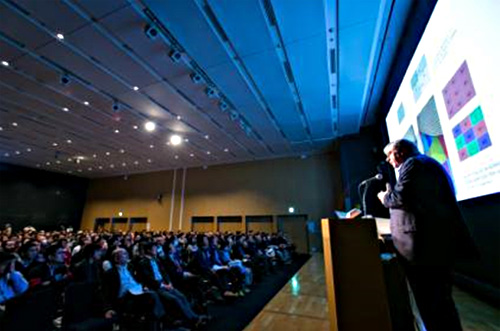
A scene from the lecture
Foster + Partners is an integrated design practice that has created many of the world's most well-known contemporary buildings, starting with the Hongkong and Shanghai Banking Corporation headquarters in Hong Kong (1979-1986), followed by the Reichstag Building, created as a symbol of German democracy at the time East Berlin and West Berlin were joined in 1989 and houses the German Parliament; the Swiss Re headquarters, symbolizing London in a new century (1997-2004), located at 30 St Mary Axe and affectionately known as “The Gherkin”; and Beijing International Airport, the main gateway to the Beijing Olympics (2003-2008).
In the 1970s, Foster + Partners was commissioned to design the headquarters of IBM UK, is currently working on the new Apple Campus 2, and has spent years researching lunar surface dwellings in collaboration the European Space Agency (ESA). Foster + Partners remains the design firm of choice for whatever company or institution is leading in its particular sphere of activity in a particular decade. At the exhibition, we saw Foster + Partners trajectory over the past 50 years. Founded by architect Norman Foster, Foster + Partners is today a huge organization employing some 1,500 staff and yet given its size, it seems to have a never-diminishing creativity from which such highly artistic architecture emerges. At the talk session, the audience was able to gain some insight into what drives Foster + Partners.
In the lecture given by David Nelson, he concluded that the source lies in the collaborative research conducted over 12 years by Norman Foster and Richard Buckminster Fuller. The photograph shows the two of them having a meeting about the Samuel Beckett Theatre Project (1971). He says that the Foster + Partners depicted in the photograph has not changed much since it was taken. The photograph shows several people having a meeting with Bucky (Richard Buckminster Fuller, who to this day the staff at Foster + Partners still refer to as Bucky) and Norman at the center, but in the group there are only two architects, one of whom is Norman. The other people there are structural engineers, cost consultants and graphic designers. According to Mr. Nelson, they created an integrated project team consisting of the top experts in their fields at the time and used to design buildings through a process of discussion back and forth between the team members.
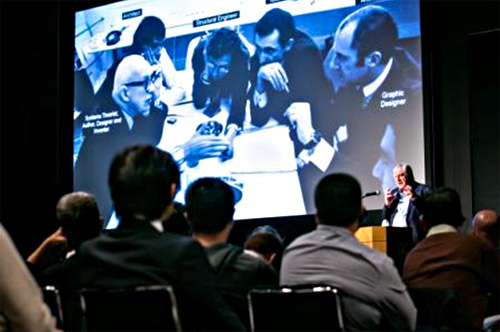
David Nelson giving his lecture
The style of the project teams continually evolve but at the same time remains exactly the same. The current Foster + Partners has six design studios, 50 percent of staff members are architects and the remaining 50 percent are experts in various different fields. All projects revolve around the design studios, and experts involved transversely in those projects (for example, acoustics experts, computer scientists, interior designers, product designers and sometimes, aerospace scientists, artists and cultural anthropologists) and specialized consultants form their own teams, which are overseen by an architect.
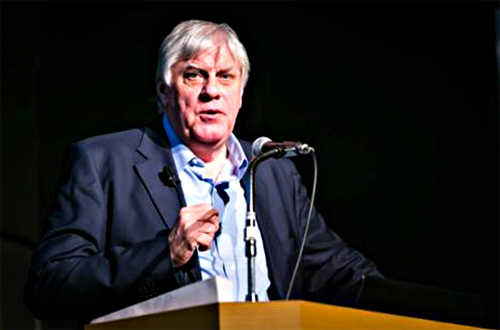
David Nelson
The project teams are constructed in the same way as one might weave an intricately and densely woven fabric. The architecture emerging from this is repeatedly corroborated in various ways, for example, in terms of community, society, technology, culture, arts, and the economy. Nelson explained that it is through this approach that Foster + Partners has been able to create the magic that is then woven into the multiple layers of a given project.
Norman Foster revolutionized the approach to architecture that had been the norm up to the 20th century, in which one architectural genius would create architecture, and by bringing together the wisdom of many people, proved that Foster + Partners has been able to create intriguing architecture for 50 years. Nelson, talked much about that theory of creation that has supported the practice over the many years while showing examples of innovative projects including recent work not presented at the exhibition and the draft plan for a driverless car that was updated based on the original design of the Dymaxion D-45 car proposed and researched by Bucky in 1947.

D-46
Foster + Partners' architecture has a consistent theme, that of “sustainable design.” Since the 1970s, Namba Kazuhiko has pursued his goal of industrializing and systemizing architecture, and has studied sustainable architecture as a means of achieving that. The theme of this lecture was “sustainable design as integration.” He provided an overview of modern and contemporary architectural history since the Industrial Revolution and explained how architecture emerges from technology and ideas of previous generations, and that the most important proposition for contemporary architecture that will connect to the future is sustainable design. Namba explained that when we understand architecture as four integrated layers, we are then able to figure out which issues should be solved by contemporary architecture and the techniques for solving them.
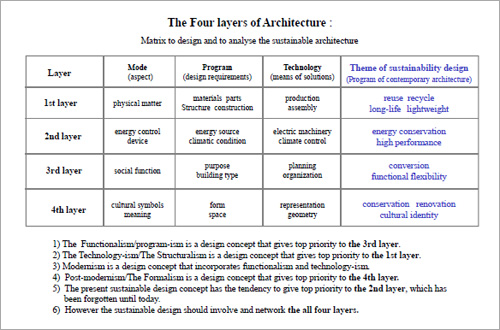
A slide used by Namba Kazuhiko
© Kazuhiko NAMBA
Namba assesses the job of Foster + Partners as no more or less than the integration of the processes shown in this matrix and putting those processes into practice. In this lecture, Namba talked out how he has been attracted to the special nature of Norman Foster's architecture since the 1970s, and that the projects Foster worked on in the early days - for example, Willis Faber & Dumas Headquarters (1975) and the Sainsbury Centre for Visual Arts (1978) - had a major impact on his own research, and that the Foster + Partners architecture that came thereafter still incorporates important practices and experiments based on the “four-layer structure” of architecture. One particular example he cited was the new German parliament building, the Reichstag (1992-1999), in his opinion a masterpiece that integrated the various issues surrounding the building until it becomes capable of “preserve and regenerate,” “social and democratic” and “energy and sustainability.”
At the end, he introduced the famous Manhattan Project in which Buckminster Fuller proposed to place a dome over New York City in order to control the outside environment, and concluded by saying that Foster + Partners will in the future continue to have the kind of vision that was demonstrated in that project.
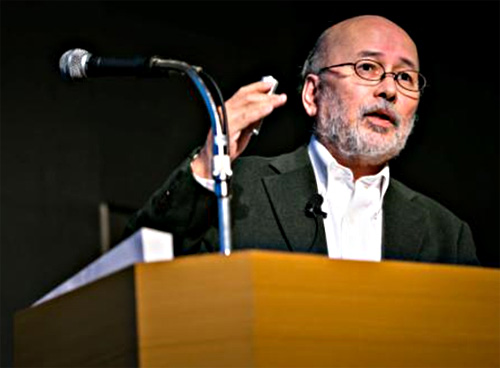
Namba Kazuhiko
In the second half, there was a discussion that progressed through Nanjo's many sharp questions and comments. When asked about the similarities and differences between Norman Foster, Richard Rogers and Renzo Piano, both Nelson and Namba pointed out that although the three architects came from different backgrounds and had different personalities, they had in common their high interest in the technology and their approaches.
In particular, Namba said that the critic Reyner Banham, who had a significant influence on the world of architecture during the 1970s and 1980s, in his well-known book Theory and Design in the First Machine Age made conclusions about Buckminister Fuller's ideas, and the fact that in his subsequent critique, he expressed sympathy with the idea that “the work of the three people resonates with Fuller” was interesting.
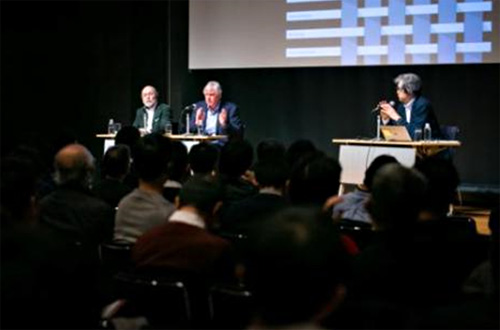
A scene from the discussion
In response to the question of how such a huge organization is able to maintain the quality of its work, Nelson explained that Norman Foster, Spencer de Grey, a member since the early days, and himself had stepped down from design work in order to nurture younger architects and changed their roles as reviewers of design. Also, on very large projects, several studios would work as a team, creating an organic and unique system that works effectively.
Foster + Partners has for 50 years survived the test of time, creating valuable architecture that will form cultural heritage for the next generation and leaving an indelible mark onto the history of architecture. We realized once more that that their architecture have been meticulously planned and created by a number of architects and experts. The talk session provided a small hint of what the future may hold to those involved in the future of architecture and urban development, and the rest of us who will be living and gathering in the places the architects create.
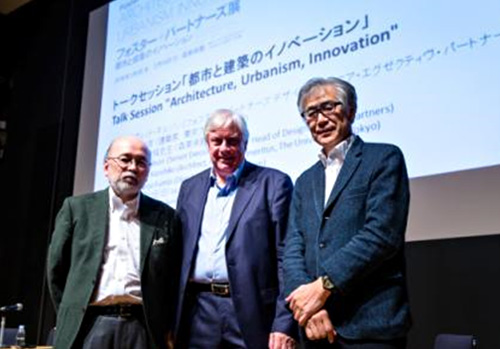
From left to right: Namba Kazuhiko, David Nelson, Nanjo Fumio
Text: Maeda Naotake (in charge of the Foster + Partners exhibition, Curatorial Group, Mori Art Museum)
Photos: Mikuriya Shinichiro
■Relevant Information
・“Foster + Partners: Architecture, Urbanism, Innovation”
Friday, January 1 - Sunday, February 14, 2016
・[flickr]Installation views of the ”Foster + Partners”exhibition!








